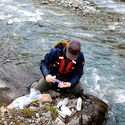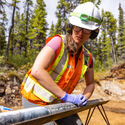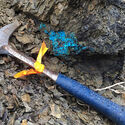Northern BC offers ESG mining benefits
Mining Explorers 2022 - January 19, 2023
Last updated 1/18/2023 at 9:09am

Galore Creek Mining Company
Outcropping copper mineralization at Teck Resources Ltd. and Newmont Corp.'s world-class Galore Creek copper-gold project in the Golden Triangle region of Northern BC.
Working with First Nations is key to unlocking the Golden Triangle's vast potential.
A world-class copper-gold district that is also enriched with nickel, cobalt, platinum group metals, and other critical minerals, the Golden Triangle region of Northern British Columbia is poised to be a major supplier of the mined commodities critical to a low-carbon future, cutting-edge technologies, and strong global economies.
"Responsible mineral exploration and development are critical to addressing our global challenges," said Association for Mineral Exploration BC President and CEO Kendra Johnston. "The minerals and metals we discover ignite global supply chains, drive innovation and technology transformation, power new energy solutions, and help achieve a low-carbon future."
The four largest and most advanced copper projects in Northern BC – Galore Creek, KSM, Red Chris, and Schaft Creek – host 4.5 billion pounds of copper in the measured and indicated categories. Aside from the exploration upside at these world-class copper-gold-silver projects, dozens of mineral exploration and mining companies are advancing other Northern BC projects enriched with cobalt, copper, gold, nickel, PGMs, zinc, and other metals.
And, thanks to the foresight and investment of the provincial government, the 287-kilovolt Northwest Transmission Line delivers hydropower to current and future mines in the Golden Triangle – a major advantage that lowers the carbon footprint and increases the environmental credentials of operations plugged into this clean energy source.
Mineral exploration, development, and production companies working in British Columbia's northern reaches can and must establish the social and governance of their ESG reputations by opening and honestly working alongside the First People that have called this mineral-rich expanse of western Canada home for millennia.
Mining companies that respect First Nations jurisdiction when it comes to land management in Northern BC will find their hosts to be a well-organized, politically savvy, and business-astute people that also happen to be sophisticated miners with generations of experience.
Exploring Tahltan Territory
While Golden Triangle is a fitting and easily marketable moniker, Tahltan Territory is a more apt descriptor for this incredibly mineral-rich region of northwestern BC.
Extending east from the Southeast Alaska Panhandle to the Cassiar Mountain range and north from the Nass and Skeena Rivers into the Yukon, the roughly 96,000-square-kilometer (37,000 square miles) Tahltan Territory covers approximately 70% of the Golden Triangle and nearly 25% of Northern BC.
"Tahltan Territory is home to British Columbia's resource rich 'Golden Triangle' and a booming mineral exploration industry," said Chad Norman Day, president of the Tahltan Central Government, the administrative governing body of the Tahltan Nation.
It is estimated that nearly half of the 2022 mineral exploration in BC was carried out in Tahltan Territory.
This flourishing mineral exploration sector has outlined world-class deposits with the potential to be developed into Golden Triangle mining operations that could join the current Red Chris copper-gold and Brucejack gold-silver mines – both operated by Newcrest Mining Ltd.
Eskay Creek, a gold-silver mine project being advanced by Skeena Resources Ltd .; KSM, an enormous copper-gold-silver project owned by Seabridge Gold Inc .; Galore Creek, a world-class copper-gold project to be developed under a partnership between Teck Resources Ltd. and Newmont Corp .; and Lawyers, a gold-silver project being advanced by Benchmark Metals Inc., are high on the list of advanced exploration projects positioned to host the next generation of mines within the Tahltan Territory.
The Tahltan Nation is taking an increasingly active role in ensuring that exploring for, building, and operating mines in its homeland offers more benefits to the Tahltan people than potential risks to the cultural and environmental resources found there.
"The Tahltan Central Government has been clear on behalf of all Tahltan people that there will be no world-class mining jurisdiction in Tahltan Territory without robust Tahltan stewardship which must include world-class wildlife and fisheries management, strong environmental mitigation measures and recognition of our 1910 Declaration," said Day.
Historic step at Eskay Creek
The Tahltan Nations' role in ensuring environmentally and culturally responsible mines in its territory was cemented by a landmark mine permitting agreement signed in June that reshapes the mine permitting process in Tahltan Territory, the province, and potentially across all of Canada.
Under this historic pact with Skeena, Eskay Creek will be the first proposed mine in BC to have permits authorized by an indigenous government, marking a significant step toward incorporating the principles of the United Nations Declaration on the Rights of Indigenous Peoples, commonly referred to as UNDRIP, into the environmental assessment process.
"Reconciliation is not achieved with just one step. It requires ongoing innovation, collaboration and leaning into discomfort," Day said upon signing the agreement. "For the Tahltan people, strengthening and preserving our culture, values and independence is why we keep pushing forward on this journey."
BC officials say the agreement for consent-based permitting of Eskay Creek honors Tahltan jurisdiction when it comes to land management decisions in its territory.
"This historic step shifts B.C.'s legal decision-making framework to respect First Nations jurisdiction, recognize the inherent rights of the Tahltan and provide a clear, stable and sustainable path for everyone to work together," said British Colombia Premier John Horgan. "By working together, we are delivering on the promise of reconciliation, supporting predictability for business and encouraging responsible investment in B.C."
By taking the lead in First Nations reconciliation and incorporating UNDRIP principles into the permitting process, the provincial government hopes to establish BC as a preferred destination for investors that are increasingly considering ESG as they weigh mine investment decisions.
"We are creating regulatory clarity and greater certainty for investors while protecting our natural environment for the generations to come," said BC Minister of Environment and Climate Change Strategy George Heyman.
This landmark decision also puts a seat at the table for other BC First Nations when it comes to the environmental assessment of mining projects in their territory and opens the door for similar consent-based decision-making processes for resource development projects across Canada.
"Together, the Tahltan Central Government and the province are leading the way toward a new model for advancing free, prior and informed consent," said BC Minister of Indigenous Relations and Reconciliation Murray Rankin.
Tahltan mine partnership
For Skeena, the agreement provides greater certainty and a solid framework for permitting a modern operation at the past-producing Eskay Creek mine.
A feasibility study completed in September details a financially robust mine at Eskay Creek that will produce 2.42 million oz of gold and 66.7 million oz of silver over nine years of open pit mining on a property that previously mined from underground.
"Eskay Creek is a truly unique deposit that provides excellent profit margins due to its existing infrastructure and very high open pit grade," said Skeena Resources CEO Walter Coles Jr.
Over the past five years, Skeena has worked closely with the Tahltan Nation and its people, a key to gaining the First Nation's consent for what is now known as the Eskay Creek Revitalization Project.
"As an already developed mine site with existing road access, waste management facilities, nearby access to green power, and robust economics, gaining consent from the Tahltan Nation on whose unceded land Eskay Creek is located, is a crucial step in an efficient approval process for the project," said Skeena Resources Senior Vice President of External Affairs and Sustainability Justin Himmelright.
Above and beyond respect and consent, Skeena has received financial backing from the Tahltan Nation.
Under the 2021 agreement, the Tahltan Central Government invested C$5 million to acquire 1.6 million investment rights at C$3.13 per right. These rights will automatically vest and convert into Skeena shares over a three-year period
"In partnering with Skeena, the Tahltan Nation is evolving and taking significant steps forward by becoming meaningful equity partners in these projects," said Day. "Ownership provides the Tahltan Nation with a strong seat at the table as we continue our pursuit towards capacity building and economic independence for the Tahltan people."
Nisga'a Nation partners with Ascot
The prior and informed consent model spearheaded by the Tahltan is playing out at other advanced exploration projects across Northern BC.
In recent years, the Tahltan Nation has reached comprehensive impact, engagement, and benefit agreements with several companies with advanced staged mineral exploration projects within its territory – including Seabridge, Coeur Mining Inc., Kutcho Copper Corp., and Benchmark Metals Inc.
While the Tahltan are breaking new ground when it comes to Indigenous involvement in mine project decision making in Canada, other Northern BC First Nations are entering into pacts that ensure mining within their regions maximize benefits for their people while minimizing environmental and cultural impacts.
Near the town of Stewart at the southern end of the Golden Triangle, the Nisga'a Nation has forged a strong relationship with Ascot Resources Ltd., which is advancing the development of mines at its Premier and Red Mountain gold-silver projects.
"I am very delighted to represent the Nisga'a Nation in our partnership with Ascot," Nisga'a Lisims Government President Eva Clayton said upon signing a renewed impacts agreement with the mineral exploration and development company in 2021. "Since the beginning, our relationship has been one based on the principle of mutual respect and a commitment to improving the quality of life of Nisg̱a'a citizens."
Under the terms of this comprehensive benefits agreement, Nisga'a Nation will provide ongoing support and continued consultation for the development and future operations of underground gold mines at Premier and Red Mountain, emphasizing respect for the land, protection of the environment, understanding of cultural use and knowledge, as well as health and safety, on and off the worksite.
A feasibility study completed in 2020 envisions a 2,500-metric-ton-per-day operation that is slated to produce roughly 1.1 million ounces of gold and 3 million oz of silver over an initial eight years of mining.
Ascot had previously planned to resume gold production at Premier by around this time but decided to postpone operations by roughly a year due to a lack of adequate financing to complete the tailings dam, new water treatment plant, and other projects that need to be finished during the summer.
"The company has a limited weather window to conduct certain outdoor construction activities and needs to ensure it has sufficient funding to complete these activities and the rest of the project," Ascot Resources President and CEO Derek White said in June.
With the window closing, Ascot decided to focus its 2022 program on continued underground development at Big Missouri, the first deposit to be mined, as well as exploration and resource upgrade drilling across the Premier property.
Giga battery metals
While the Golden Triangle is best known for deposits enriched with the copper needed for the low-carbon economy, the gold treasured as hedge against inflation, and silver that lands in both categories, this region of Northern BC also hosts deposits that could help fill the massive demand for nickel and cobalt with a responsibly sourced supply of these battery metals.
The largest and most advanced of these battery metals projects is Turnagain, a large nickel-cobalt deposit being advanced by Giga Metals Corp.
A 2021 preliminary economic assessment outlines plans for a mine at Turnagain that would produce an average of 33,215 metric tons of nickel and 1,962 metric tons of cobalt annually over a 37-year mine life.
In addition to the ESG advantages inherent to developing a mine in BC, Turnagain offers another attractive environmental quality – the tailings from mining the nickel and cobalt at Turnagain would be ideally suited for absorbing carbon dioxide out of the atmosphere.
A team led by University of British Columbia Professor Greg Dipple, who has been studying mineral sequestration of CO2 in mine tailings around the world for more than 15 years, shows the potential for Turnagain to permanently lock up vast amounts of CO2 as carbonate mineral.
Initial testing of Turnagain material showed an average annual absorption rate of 2.7 kilograms of CO2 per square meter.
At this rate, Giga calculates that a mine at Turnagain could absorb 0.72 metric tons of CO2 per metric ton of nickel produced.
Considering that this operation is estimated to emit 0.75 metric tons of CO2 per metric ton of nickel with an electric haulage fleet charged with BC Hydro power, this baseline absorption would nearly make the mine carbon-neutral without any optimizations.
Dipple's testing, however, indicates that the CO2 absorption rates would increase under actual mining scenarios.
"We now have empirical data that supports our ambition to build the world's first true carbon-neutral nickel mine, meaning a project that achieves carbon neutrality without purchasing carbon credits," said Giga Metals President Martin Vydra.
The testing also showed that only about 10% of the brucite – a magnesium hydroxide mineral at Turnagain responsible for sponging atmospheric CO2 – was consumed during the one-month sequestration test, indicating that Turnagain mine tailings would absorb more of the greenhouse gas with longer exposure to the air.
While much more detailed and longer-term testing will need to be done, a mine at Turnagain with an electrified mining fleet powered by the hydroelectric Northern BC is known for has the potential to be a CO2-negative producer of nickel and cobalt.
"We recognize the growing importance of strong ESG performance from commodity producers," said Vydra. "We are proud that our project is at the forefront of being able to contribute to a carbon-free industry."
















Reader Comments(0)